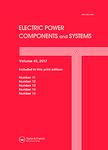版权所有:内蒙古大学图书馆 技术提供:维普资讯• 智图
内蒙古自治区呼和浩特市赛罕区大学西街235号 邮编: 010021

作者机构:Urmia Univ Dept Power Engn Fac Engn Orumiyeh Iran
出 版 物:《ELECTRIC POWER COMPONENTS AND SYSTEMS》 (电力部件与系统)
年 卷 期:2018年第46卷第13期
页 面:1462-1477页
核心收录:
学科分类:080801[工学-电机与电器] 0808[工学-电气工程] 08[工学]
主 题:security constrained optimal power flow reliability expected power not served operating cost nondominated sorting genetic algorithm
摘 要:Intensive researches have been investigated the security aspect of optimal power flow (OPF) problem. The primary objective of them is to ensure the reliable and continuous supply to the consumers as economically as possible. Although all of these researches offer valuable solution to enhancing security constrained OPF (SCOPF), they avoided a discussion on the operation cost of power system versus the security constrains. The understanding of relationship between the operation cost and system security leads to make best decisions on tradeoffs between operating cost and system reliability. The main objective of this article is to solve preventive/corrective SCOPF (P/C-SCOPF) problem considering the expected power not served (EPNS) index as security constraint. Also, the relationship between operation cost and EPNS index is discussed in detail. In this article, well-known nondominated sorting genetic algorithm (NSGA) is used to determine the precise relationship between operating cost and the security constraint (EPNS), for the first time. This would result in illuminating information that can be utilized to make a reasonable decision on the best tradeoffs between operating cost and reliability of system. The proposed approach has been evaluated on IEEE 14 and 57 bus test systems and results have been discussed.